Optimized platform for biospecimen processing and immunophenotypic and functional biomarker evaluations
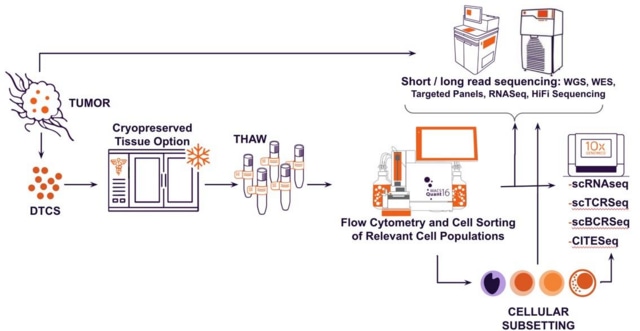
Introduction
Access to highly-annotated primary human tissues is an integral part of precision medicine research and development, but the logistical barriers of acquiring fresh tissue have persisted over many decades. These logistical challenges are only amplified during the global pandemic, where, despite managing a giant clinical collection network, Discovery Life Sciences has observed reductions in tissue accrual during the COVID19 pandemic. To alleviate these logistical demands, Discovery has established standardized protocols for tissue resection, shipment, dissociation, and cryopreservation at two central processing facilities. These considerations ensure that all tissue samples are handled within timeframes for optimal cell recovery under a single chain of custody, to produce high-quality viable tumor samples. These cryopreserved dissociated tissue cells (DTCs) provide the opportunity to understand the complex cellular composition of solid diseased and normal tissue at the single-cell level without the need to source new fresh tissue for each analytical assay.
Cancer is inherently heterogeneous, genomically unstable, and further complicated by tumor and tumor microenvironment modulated immunosuppression. Scientists must therefore understand the interplay of these cellular subsets to successfully develop efficacious treatments, but with limited fresh tissue supplies, inflated costs, and the need for large-scale analyses, this monumental task is made even more difficult. My team was the first to develop DTCs as a robust alternative to sourcing fresh tissues, so our clients could evaluate their monoclonal antibodies, immune adjuvants, cell-based therapies, and vaccines quickly, cost-effectively, and at the scale required to make informed strategic decisions.
Dr. Shawn Fahl
Senior Director, R&D and Laboratory Processes at Discovery Life Sciences
How are DTCs Created?
Dissociated tissue cells are generated from solid diseased and normal tissue via enzymatic and mechanical dissociation and represent a single cell suspension of the cellular components of the parent tissue, including tumor/normal epithelial cells, immune cells (T Cells, B Cells, NK cells, myeloid cells), endothelial cells from blood vessels, and fibroblasts.
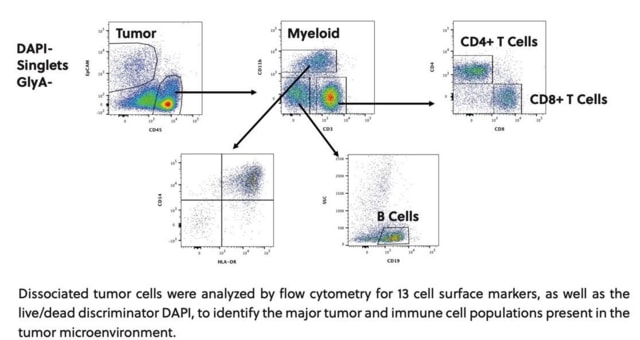
Following dissociation, cells are cryopreserved and stored long-term in liquid nitrogen vapor phase. High viability is observed both immediately following dissociation as well as post-cryopreservation, providing quality cellular material for downstream analytical assays.
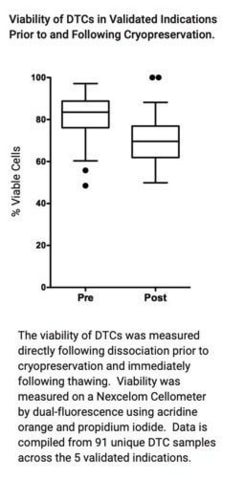
Additionally, by cryopreserving the dissociated samples, detailed and complete annotation of the sample can be collected, including donor age, race, ethnicity, gender, as well as tumor subtyping and staging. Furthermore, biomarker status can be evaluated to look for therapeutically relevant mutations and biomarker expression to select the correct specimens for further analysis.
What Downstream Assays can DTCs be Used for?
Dissociated tissue represents an optimal and efficient starting material for numerous downstream assays. As DTCscontain all of the cellular components of the parent tissue, they can be analyzed for the combined cellular make up of the tissue or further processed to examine specific subsets from the larger cellular pool. Immunomagnetic isolations, such as the Miltenyi Tumor Cell Isolation Kit and CD45 (TIL) Microbeads, can be used to efficiently isolate unlabeled tumor cells and immune cells, respectively, from the complex cellular composition of the tissue. For more specific cell isolations, DTCs can be cell sorted using any conventional cell sorter. Discovery does recommend the use of live/dead discriminators as well as a red blood cell marker, such as CD235a, to aid in the purification of cell populations from DTCs. In addition to purification, DTCs can also be cultured, both in short-term spheroid and long-term organoid models, to evaluate therapeutic drug responses.
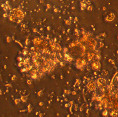
Spheroid culture from lung DTC sample cultured for 3 days.
Following any additional processing of the specimen, DTCs are amenable to many bulk and single-cell analytical workflows. Flow cytometry is utilized to examine not only the cellular composition of the original tissue but also the cell surface expression of known and novel biomarkers and therapeutic targets. Indeed, Discovery studied the expression of PD1 and PDL1 on the cellular components from diseased and normal tissue, and specifically how flow cytometric analysis of PDL1 compared to IHC analysis of PDL1 in matched FFPE tissue. Read more in our Checkpoint Inhibitor Therapy Utilization and PD1/PDL1 Expression Across a Global Clinical Network white paper. These analyses have been further extended to additional immunomodulatory receptors, such as TIGIT/PVRL2. Bulk sequencing of DTCs is used to identify common variants and fusion proteins, as well as broader whole-exome sequencing and bulk RNA sequencing for unbiased genomic analysis. Read more about Discovery’s comprehensive global analyses of DTCs in our Genomic Analysis of Dissociated Tumor Cells technical note.
In addition to these bulk genomic applications, single-cell genomics is also routinely performed on DTCs to understand the cellular composition and expression of target genes within the sample. Using 10X Genomics single-cell workflows, Discovery has evaluated single gene expression in numerous DTC samples across many oncology indications, including lung cancer, colorectal cancer, kidney cancer, and head & neck cancer. Additionally, a single-gene immune repertoire, both at the T cell receptor and B cell receptor loci, has been performed to identify potentially tumor-reactive T cells, for example. Finally, barcoded antibodies have been utilized to perform CITESeq on DTC samples to understand both the gene and protein expression within the complex solid tissue. Collectively, these analytical workflows allow for extensive analysis of the genetic and cellular components of the parent tissue.

TIGIT/PVRL2 Expression within the Tumor Microenvironment by Flow Cytometry.
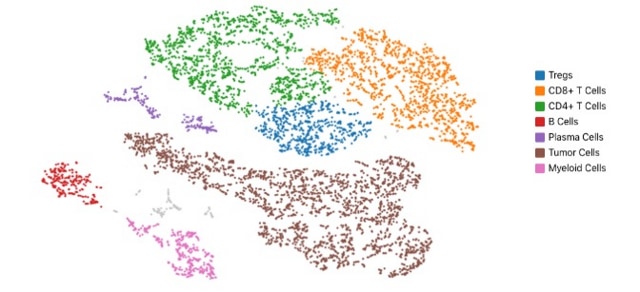
Single Cell Genomics Evaluation of CRC DTC Sample
Conclusion
DTCs mimic the tumor microenvironment by including tumor, immune and stromal cells which makes them an ideal alternative to fresh tissues. They deliver accessibility, lower costs, and diverse utility in downstream applications to help scientists meet increased demand and overcome fresh tissue shortages and logistical challenges. Discovery’s cell service lab’s expertise and our integrated multi-omic services deliver a unique suite of solutions to help advance precision oncology programs.

